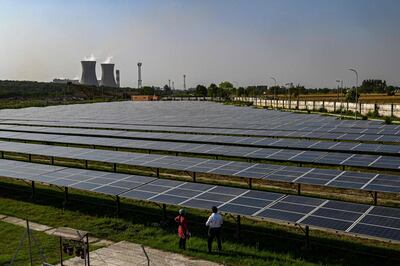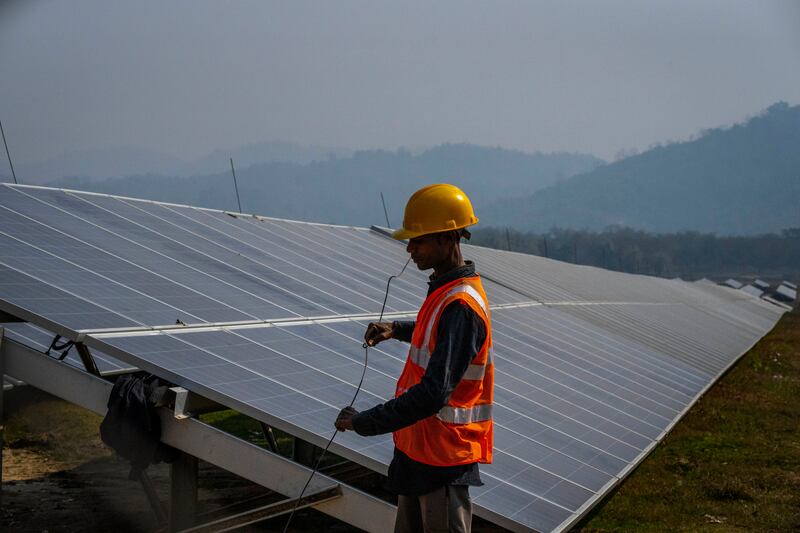For Indian manufacturing company Gautam Solar, the country's push towards renewable energy is creating enormous opportunities for it to scale up its operations.
It started out making solar components, before expanding to take on the more complex production of solar panels.
“We started solar module [panel] manufacturing as we recognised the huge potential for renewable energy, especially solar energy in India, and to cater to a growing market that was inundated with cheap Chinese solar modules,” says Shubhra Mohanka, director of Gautam Solar.
The New Delhi company is among those benefiting as India ramps up its efforts to manufacture more critical components that can play a crucial role in the country’s transition to green energy.
These include semiconductors, solar panels and energy storage systems.
This comes as India is aiming for 500 gigawatts of renewable energy capacity by 2030 – as it seeks to reduce its dependence on costly imports of polluting fossil fuels.
The country is heavily dependent on coal for most of its electricity generation.
As energy requirements grow rapidly with an expanding economy, India needs alternative, cleaner sources of power if it is to meet its goals of reducing its carbon emissions – including Prime Minister Narendra Modi's target for the country to become net zero by 2070.
However, India has been heavily dependent on imported components essential to renewable energy infrastructure, including semiconductors from Taiwan and solar panels and batteries from China.
To meet its renewable energy targets, the government has increasingly been offering incentives for companies to manufacture critical components.
New Delhi is planning a new $2.6 billion subsidy scheme for companies manufacturing electricity grid batteries, the Financial Times reported this week.
Dr Sultan Al Jaber says this is the decade to provide clean energy the world needs

“India has ambitions to boost domestic manufacturing encompassing the whole value chain of renewable energy, including grid batteries,” says Vibhuti Garg, South Asia director at the Institute for Energy Economics and Financial Analysis think tank.
These are vital in the use of renewable energy sources including solar and wind, because this power is not available round the clock and storage of the energy generated is needed to maximise its potential.
“India wants to reduce reliance on imports as the country's renewable ambition and goals were hit due to Covid-19 and Russia-Ukraine war which led to supply disruptions,” says Ms Garg.
“Further, setting up manufacturing capacity will create more jobs and spur economic growth in India.”
Boosting manufacturing grid batteries locally would reduce costs, which could have an enormous impact on the potential more widespread use of green energy, she says.

“Currently, higher prices of batteries have limited deployment at a large scale. The government is expecting that large scale manufacturing capacity will help in bringing the price down and which will accelerate deployment of renewable energy,” says Ms Garg.
However, the country is still “at a very early stage in terms of its manufacturing capacity for electricity grid batteries”, says Barnik Maitra, managing partner at consultancy Arthur D Little, India.
He says that there are also hurdles including regulatory issues and environmental challenges, with the manufacturing of these batteries in and of itself requiring “a significant amount of energy and resources”.
Rishabh Jain, senior programme lead at the Council on Energy, Environment and Water think tank, says that scaling up India's battery manufacturing will take time, and the country will have to grapple with the existing and expanding competition.
“Many countries – US, Europe and South Korea – have doubled down on their policy support for developing the local supply chain for battery manufacturing,” says Mr Jain.
“The manufacturing scale will also be a pressing issue, as global manufacturers operate at scales Indian manufacturers will not match for a while.”
Despite the challenges, building up its capabilities and capacity to manufacture batteries, solar modules, and semiconductors, will be “critical for India's transition to clean energy and for wider economic benefits”, Mr Maitra says.
The government's Make in India initiative aims for India to become a global manufacturing hub – as the world's most populous nation strives to accelerate economic growth and create more jobs.
In addition to this, India has in recent years already managed to substantially increase its production of solar panels, partly by providing production-linked incentives to manufacturers.
Gautam Solar’s Ms Mohanka says that there are several subsidies that are available for solar panel manufacturers in India, and these have been “a tremendous booster to the domestic manufacturing of solar modules”.
“More incentives for solar module manufacturing will be ideal to make Indian solar modules more cost-competitive on a global scale”, she says.
There are also other challenges.
“The major hurdles holding back manufacturing of solar modules in India are access to financing, shortage of skilled workforce and technology and infrastructure limitations,” says Ms Mohanka.
“The interest rates in the domestic renewable energy market are 8 to 10 per cent compared to 3 to 4 per cent for western markets.”
Although India is making more solar panels, it still depends on China for imports of components including solar cells and the initial processing of polysilicon, she adds.
However, the progress has been enormous and encouraging, experts say.
“If India is able to scale up domestic manufacturing in the next few years, it will not only be able to meet the domestic demand but also supply to the world and strengthen the global supply chain of solar modules,” says CEEW's Mr Jain.
India is also hoping that it can become a hub for semiconductor manufacturing and exports, one of the benefits of which would be helping in the country's local production of electric vehicles.
Chip manufacturing in India is still at a nascent stage. But significant progress was made in June when US chip maker Micron said it would invest up to $825 million to set up a semiconductor assembly and testing facility in the western state of Gujarat.
Further support from the Indian central and state governments would bring the total investment up to $2.75 billion. The announcement was made during Mr Modi's visit to the US in June.

In May, India reopened the application process for a $10 billion incentive scheme to encourage chip manufacturing, Bloomberg News reported.
“India's manufacturing of critical components, particularly semiconductors, holds immense significance for the electric vehicle industry,” says Visakh Sasikumar, founder of Fyn Mobility, an electric vehicle ecosystem platform in India.
“By producing these components domestically, India can reduce its reliance on imports, bolster supply chain resilience and expedite the widespread adoption of electric vehicles, thereby propelling the country's economy towards a cleaner and more sustainable future.”
Localised manufacturing of chips could help to make electric vehicles less expensive to produce and therefore cheaper for consumers, he adds.
India is headed in the right direction as it aims to improve its energy security, reduce carbon emissions and expand its economy through its mission to make more components that are vital in the renewable energy chain – but there is still a long road ahead, industry experts say.
“India's plans to increase production of components such as semiconductors, grid batteries and solar modules are truly ambitious,” says Nitin Rakesh, professor and head of the computer science and engineering department at Sharda University in Greater Noida, near New Delhi.
“While India has the resources, capabilities and political support, there are challenges in areas such as supply chain, infrastructure, technology and capacity development,” says Prof Rakesh.
“India has made progress, but it is important to recognise that building a strong domestic manufacturing ecosystem will take time.”






